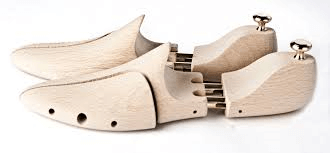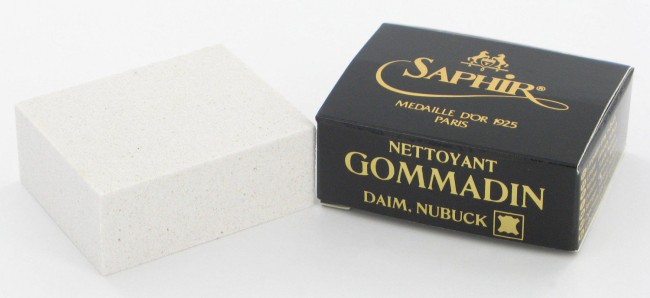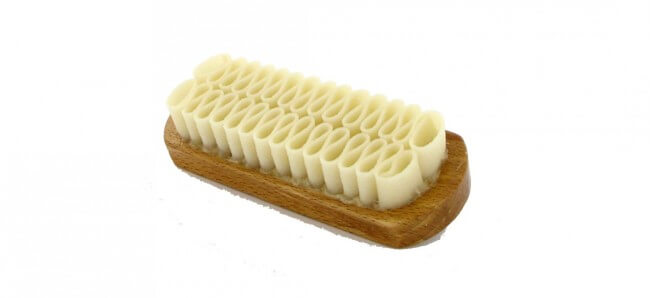Shoe Care Part 2: Suede
If you have spent time reading through articles on ModernGentlemanMagazine.com, it should be no surprise that we advocate for buying high quality items, made by those with a passion for what they do. In short: buy better quality items, and support the artisans that truly care about what they make. Acquiring items of quality is only half the battle, however. After all, one of the arguments for owning quality items is being able to enjoy them for a long time to come. It also may give you the opportunity to pass them on to a future generation of gentleman, for their enjoyment as well. It’s from that perspective, that this series of articles is based. Over the coming weeks and months, we will look at how to care for, and prolong the life of the items in your wardrobe.
Part 2: Suede Shoes

Alfred Sargent Browning in Snuff Suede (courtesy: Leffot)
For some reason, suede shoes have taken on a reputation as being difficult to care for, unable to stand up to the elements, and requiring “babying” to prolong their lives. I’m happy to tell you that none of these points are, in fact, correct. With some simple care, and easily applied protective measures, suede shoes can be worn in any and all conditions without fear. Take my word for it… I used to believe that suede shoes could be easily ruined, but I have come to find that suede footwear is remarkably resilient. For that reason, I often reach for my suede shoes on rainy and even snowy days, as opposed to my smooth calfskin leather shoes. As in Part 1, I will break down the care of suede shoes into 3 categories, daily care, routine care, and occasional care:
Daily Care

Split-toe Shoe Trees (courtesy: the Shoe Snob)
Shoe Trees: Similarly to caring for calfskin footwear, the best piece of advice I can share for daily care of suede footwear is to use shoe trees. See Part 1 for a more detailed description of shoe trees and how to use them. One important point to note: If your suede shoes are unlined (meaning there is not a leather lining on the inside of the suede uppers, that provides additional structural strength) know that shoe trees could potentially stretch the suede uppers over time. Spring loaded shoe trees, in particular, can provide a significant outward pressure that can stretch unlined suede. I recommend you observe how shoe trees affect your pair of shoes over time. It may be best to insert shoe trees for a short period of time immediately after wearing, and then remove them. This will allow the trees to absorb moisture from the day, but will keep them from significantly stretching the uppers.

Shoe Horn (courtesy: Epaulet New York)
Shoe Horn: Again, see Part 1 for more detail on using shoe horns. Putting on your shoes with a shoe horn can help prolong the life of the heel counter. A crushed heel counter is not easily repaired!

Saphir’s Suede Eraser (courtesy: the Hanger Project)
Suede Eraser: Suede erasers (typically the same consistency as a pencil eraser) are sold by many brands. These erasers can be scrubbed on the suede uppers to remove stains, watermarks, soiling, etc. Similar to a pencil eraser, a suede eraser crumbles slowly with use, and should not affect the color of the suede. Using a suede eraser is the quickest and easiest way to keep your suede uppers looking fresh and clean.

Saphir’s Crepe Suede Brush (courtesy: the Hanger Project)
Suede Brush: Suede brushes can be used to disturb and restore the “pile” or “nap” of a suede upper. This is similar to how a vacuum cleaner restores an even pile to shaggier carpets. There are two purposes that this accomplishes: (1) to help remove deeply ingrained dirt or grime, or (2) to simply restore the nap of the suede and restore the visual interest of the leather. Suede brushes come in many shapes and sizes, and even in different brush or bristle materials. I have used cheaper brushes with plastic bristles, but always felt like they could cause damage to the suede itself. I have since switched to a crepe brush (as seen above). The crepe “bristles” are more flexible. They serve the purpose of a suede brush well, but also seem to be more gentle on the leather itself.
Routine Care

Saphir’s Suede Cleaner (courtesy: A Fine Pair of Shoes)
Suede Cleaner: Over time, your suede shoes will accumulate dirt and grime deep within the pile that even suede erasers and brushes cannot remove. Suede cleaners are similar to shampoo, and can be worked into the suede (often times with a brush or cloth) to deep clean the suede. These cleaners are formulated to remove dirt and grime, but will do no harm to the suede itself. If the cleaner is used properly, your suede shoes should look cleaner and brighter afterwards. One of the benefits of suede is that it does not scratch or scuff like calfskin or other smooth leathers. With regular cleaning, your suede shoes can look clean and new for many years.
Also read: Driving Shoes – Perfect Summer Footwear

Terrago Nano Protector (courtesy: the Hanger Project)
Suede Protectant: As I mentioned above, if treated properly, suede is remarkably resilient. Applying a suede protectant spray as soon as you purchase your shoes, and following regular cleanings is a must. These sprays will make the suede repel water. If unprotected, suede can absorb water similar to a towel, which is obviously not good when it comes to leather. The suede protector above, Terrago’s Nano Protector is a fantastic product that I cannot recommend enough. Just minutes after application, you can literally pour water over the shoes and watch as it harmlessly flows off of the uppers, almost like over an invisible force field.
Occasional Care
Re-soling/Re-crafting: Also discussed in Part 1, shoes that are constructed in one of the traditional methods can likely be re-soled or re-crafted to extend their life. If you shoes were constructed with a hand welt, Goodyear welt, or Blake stitched construction (to name a few examples), the method with which the outsole is joined to the shoe will allow for the sole to be easily replaced. Re-crafting typically involves re-soling a shoe, however it also typically includes some form of restoring the finish on your uppers. Most reputable cobblers, or high-end shoe makers can deep clean suede uppers, restoring them to their original glory. With well maintained suede uppers and occasional re-soling or re-crafting, you can enjoy your suede shoes for many, many years.
In summary, shoes made from high quality suede are not only a beautiful and fantastic addition to your collection, but they can be remarkably resilient, “workhorse” shoes. Shoes made from suede that are properly maintained can truly retain the look that they had on the day you first opened the box. As always, we welcome any additional tips you have on caring for suede footwear… Please share them in the comments below.
